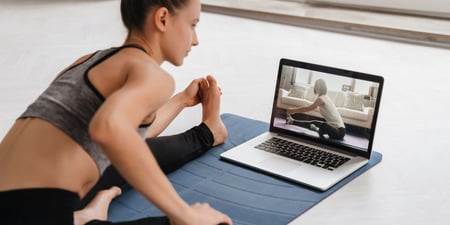Ease And Grace Through Stretch Therapy
Tim Barrett
|
27 Feb 2025

Stretch Therapy[1] is a term created by Kit Laughlin[2] who created and formerly ran the Strength & Flexibility courses at the Australian National University Sports Union. Recognised as being a leading expert in his field (and also my teacher). Kit has, for many years, treated people suffering from restrictive movement and pain using a combination of techniques derived from yoga, martial arts, gymnastics and the science of Proprioceptive Neuromuscular Facilitation (PNF).
Stretch Therapy Defined
Kit defines Stretch Therapy as “a comprehensive system that includes stretching, fascial re-modelling, strengthening, neural re-patterning and relaxation. The goals are grace and ease, and this is experienced as enhanced awareness and elegance”.
In practical terms, during a therapy session, a Stretch Practitioner will look for a restricted range of motion, imbalances between left and right or front and back, and dysfunctional muscle groups or movement. They will then guide you through specific stretches or exercises to harmonise your body’s movement.

How Does It Work?
Stretch Therapy goes beyond stretching your neck, back and shoulders to work out those kinks from sitting at a desk all day. Here’s how it works: As your muscles tighten, blood and lymphatic vessels compress, which leads to restricted flow throughout the body. Consequently, insufficient amounts of oxygen and nutrients are delivered to particular areas. As a result, the removal of waste products that evolve from normal cell metabolism, such as lactic acid and carbon dioxide, is restricted.
You may be aware that lactic acid can cause a considerable amount of pain. Additionally, tight muscles are also responsible for compressing nerves, which causes further pain.
To reverse the effects of tight muscles, stretching allows muscles to relax and more efficient blood and lymph flow to resume.
The Mind-Body Connection
Where does all our muscle tension actually come from?
Why is it that when two people are doing the same job one ends up with muscle issues and the other doesn’t?
The answer lies in the origins and ethos of Traditional Chinese Medicine (TCM).
The theory of Qi (Chinese philosophy calls our ‘vital energy’ Qi) moving through the body which underpins acupuncture, suggests that each organ is connected to our emotional and mental states. For example, when there is dysfunction with our thought processes or an unresolved emotion, the muscles connected to that energy channel become tight.
This helps us to understand how stress can lead to tense muscles in the shoulders, neck and jaw. It is the mind affecting the body. But did you know that roles reverse and the body can affect the mind? Holding tension in our jaw and shoulders can make us feel even more agitated. Just by sitting still with rounded shoulders, hanging your head can make you feel more depressed. Give it a try, and compare it to walking with your shoulders drawn back, chin lifted, while breathing deeply.

Stretch Therapy and Yoga: What’s the Difference?
Yoga classes incorporate elements of Stretch Therapy, so you may be wondering if there is any difference between the two disciplines.
Put simply, Stretch Therapy is to yoga what personal training is to aerobics. While Stretch Therapy adopts some of the major yoga poses, it focuses on detailed anatomy and physiology components. Techniques will zero in on specific dysfunctional patterns and give you optimum methods to reignite your body and mind with awareness and grace as effectively as possible.
How Can Stretching Help Me?
-
Stretch Therapy can assist with a wide range of symptoms and conditions including lower back pain and sciatica
-
Neck and shoulder pain/tightness
-
Tennis elbow
-
Tension headache
-
Pain in the hip, buttocks, calf, hamstrings, forearms
Benefits Of Stretching:
-
Reduces muscle tightness
-
Increases flexibility and range of motion
-
Enhances athletic performance and reduces the chance of injury
-
Promotes faster recovery from injuries
Stretch Therapy classes can be conducted in yoga studios or one-on-one. If you feel you would benefit from this approach to wellness, make time to speak to a practitioner who can tailor to your individual needs.
References
1. Home. Stretch Therapy; 2025.
2. About the Founder – Kit Laughlin. Stretch Therapy; 2025.
Nourishment For Your Soul Delivered To Your Inbox
Disclaimer: This Content has been developed from our generous global community and is intended for informational purposes only. This Content is not, nor is it intended to be, a substitute for professional medical advice, diagnosis, or treatment and should never be relied upon. Further, the personal views and experiences published are expressly those of the author, and do not represent the views or endorsement of SoulAdvisor through the act of publication on our site.



















































